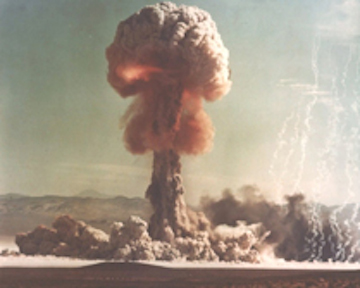400616-bomb tracer.jpg

Aboveground nuclear test conducted at the Nevada Test Site on May 25, 1953. Credit: Nevada Department of Environmental Protection
It’s been decades since any country exploded a nuclear bomb in the atmosphere. Yet many of the byproducts of those blasts are still with us. And one of them helps scientists track ocean currents.
From 1945 to 1980, the world conducted about 500 nuclear tests in the atmosphere, at sites scattered around the world. Most of those sites were in the northern hemisphere, so much of the radioactive debris fell into northern oceans — especially the North Atlantic.
The fallout included tritium, a “heavy” form of hydrogen. Before the explosions, there were only a few pounds of it on the entire planet. But the blasts created many hundreds of pounds of tritium. It was carried to high altitudes, where it combined with oxygen to make a heavy form of water. The water then rained either directly into the oceans, or onto the land, where much of it washed out to sea in rivers.
There are good records of when and where the tritium fell to earth, so scientists know where it entered the oceans. They can then sample the water around the world to see how the tritium moves. That reveals details about ocean currents, and about how long it takes water to move from the surface to greater depths.
There’s only a small fraction as much tritium around today as when atmospheric testing stopped. It hasn’t gone anywhere. Instead, it’s decayed to a stable form of helium. That can be detected in water samples as well. So scientists are still using the byproducts of nuclear explosions to track currents in the world’s oceans.

